Roden 1/32 Pfalz D.III
|
KIT #: |
613 |
|
PRICE: |
$ 64.99 MSRP
|
|
DECALS: |
Six options |
|
REVIEWER: |
Tom Cleaver |
|
NOTES: |
|
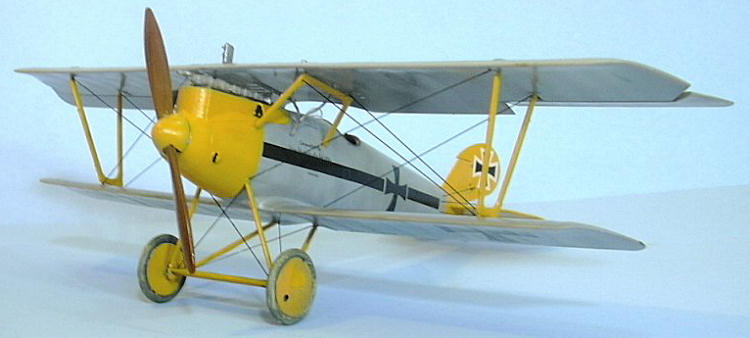
Pfalz Flugzeug-Werke GmbH of Bavaria obtained a
license to produce Morane aircraft in 1914, shortly before the commencement of
the First World War.
Following the success of the Fokker Eindekker in 1915, the company
modified the Morane “parasol” design to one similar in layout to the Fokker
airplane. The
Pfalz Eindekker was heavier than the Fokker, and didn’t perform as well - this
would be the story of Pfalz fighters throughout the war: the best second choice.
As a Bavarian company, Pfalz’ Eindekker equipped units of the Bavarian air
force.
Pfalz obtained a subcontract to build the Roland
D.II, which gave them experience in the singular Roland method of building a
monocoque wood fuselage, using wrapped wood strips to make a light yet strong
structure. Building on this experience, Pfalz set out to design a fighter superior to the
failed Roland design, that could compete with the Albatros D.III series.
Fortunately for Roland, the one thing they did absolutely right in
this decision was to keep the smaller lower wing built with a standard double
spar; no Pfalz fighter ever suffered the structural failures that plagued
Albatros once they went over to the single-spar lower wing sesquiplane design.
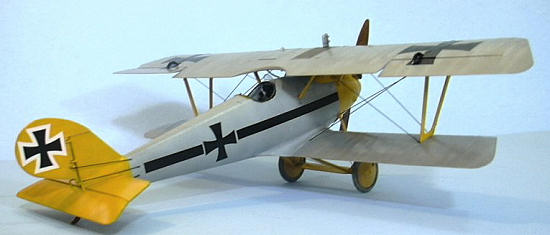 Designed in late 1916 and flown in the spring of
1917, the Pfalz D.III was powered by the same 160 h.p. Mercedes the Albatros
used, giving it a speed of 103 mph, which was slower than the Albatros and
attributable to the extra weight of the Pfalz design.
While the airplane was more directly comparable to the Albatros D.III,
it entered service in August 1917 at around the same time as the Albatros D.V
and D.Va.
Designed in late 1916 and flown in the spring of
1917, the Pfalz D.III was powered by the same 160 h.p. Mercedes the Albatros
used, giving it a speed of 103 mph, which was slower than the Albatros and
attributable to the extra weight of the Pfalz design.
While the airplane was more directly comparable to the Albatros D.III,
it entered service in August 1917 at around the same time as the Albatros D.V
and D.Va.
The Pfalz D.III was criticized for having heavy
controls, lack of speed, and lack of power - or lack of climb when compared to
the Albatros (it took 17 minutes to reach 16,000 feet). The D.III was found to
stall sharply and spin readily, going into a flat spin if not recovered quickly.
The D.III also slipped in turns and lost altitude readily, which led to crashes
when unwary pilots turned at very low altitudes.
The Pfalz D.III served primarily with units of
the Bavarian Air Force, though many pilots in the Luftkreitskraft (German
Air Service) preferred the Pfalz to any of the Albatros fighters, primarily due
to the fact that while it might not have been as maneuverable, it could be
thrown around the sky without fear of losing a wing.
“Iron man” Hauptman Rudolf Berthold, who had been badly wounded in his
left arm, liked the airplane because the throttle was on the stick, allowing him
to fly the Pfalz one-handed.
Being heavier than the Albatros fighters and also unlikely to come
apart when pulling out of a prolonged dive, the Pfalz D.III was a favorite for
attacking observation balloons along the front.
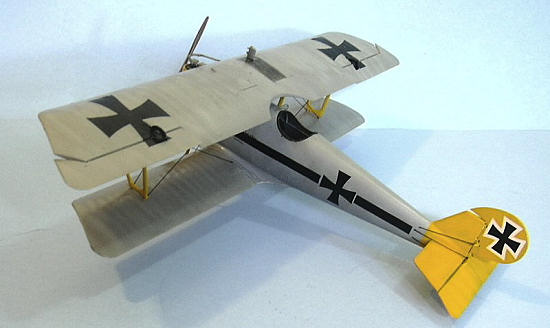 The one major problem found with the D.III was the
fact its twin Spandau machine guns were mounted inside the fuselage; this made
it difficult to clear a jam in combat, since the pilot would have to lean over
and look inside the cockpit to reach the weapons. The D.IIIa - which entered
service in late 1917 - solved this problem by mounting the guns atop the
fuselage ahead of the cockpit.
The one major problem found with the D.III was the
fact its twin Spandau machine guns were mounted inside the fuselage; this made
it difficult to clear a jam in combat, since the pilot would have to lean over
and look inside the cockpit to reach the weapons. The D.IIIa - which entered
service in late 1917 - solved this problem by mounting the guns atop the
fuselage ahead of the cockpit.
The D.III and the Albatros series were quickly
overshadowed by the introduction of the Sopwith Camel, the S.E.5a, and the SPAD
fighters. By
late 1917, the German air service was being regularly out-flown by the more
numerous Allied fighters, which led to the priority design of the Fokker D.VII
and the re-equipment of the German Jastas in the spring and summer of 1918.
Pfalz produced 260 D.III and 750 D.IIIa aircraft
by April 1918 when production ceased in preparation for the Pfalz. D.XII.
430 D.IIIa scouts were in service in June 1918; by August, the number
had dropped to 166, with most withdrawn from frontline units and assigned as
trainers.
Hans Klein:
Hans Klein was born on January 17, 1891, in
Stettin. Completing school before the outbreak of war, he joined the Army and
became an infantryman on the Western Front.
Commissioned in March 1915, he transferred to the Luftkreitskraft
a year later and was assigned to Jasta 4 in November 1916. He
achieved his first victory in the first week of “Bloody April” 1917.
Klein’s
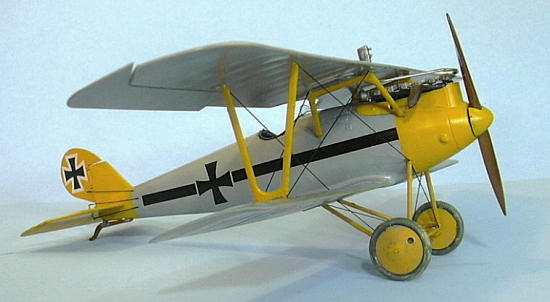 seventh
victory was scored on April 13, 1917, when he shot down the F.E.2b flown by
7-victory ace Captain Lancelot Lytton Richardson who was killed and his observer
captured in this fight. Klein was wounded in action on May 9, 1917. Returning to
Jasta 4 in late June, he was wounded again on the morning of July 13,
1917, by which time he had scored 16 victories.
seventh
victory was scored on April 13, 1917, when he shot down the F.E.2b flown by
7-victory ace Captain Lancelot Lytton Richardson who was killed and his observer
captured in this fight. Klein was wounded in action on May 9, 1917. Returning to
Jasta 4 in late June, he was wounded again on the morning of July 13,
1917, by which time he had scored 16 victories.
Following recovery from these wounds, Klein was
promoted Jastafuehrer of Jasta 10 on September 27, 1917. Jasta
10 was the first German fighter unit to equip with the Pfalz D.III.
Flying the D.III, Klein scored 6 more victories before losing his
right thumb in combat on February 19, 1918. He rejoined Jasta 10 in May
1918, but served the remainder of the war as a ground officer.
Klein joined the new Luftwaffe in 1935 and
eventually served as Deputy to Adolf Galland, General der Jagdflieger. He
achieved the rank of Generalmajor before his death in a flying accident in 1944.
Roden’s Albatros D.III is like many of their 1/32
kits, in that its basic design is scaled up from smaller models, though there is
significantly more detail in the engine compartment and the cockpit.
The wings have Roden’s excellent fabric surface representation, with
separate ailerons and thin trailing edges.
The rudder and elevator are also separate, allowing the model to be
given a dynamic pose.
Decals are provided for six different aircraft,
including the well-known D.III flown by Hans Klein as leader of Jasta 10 in the
fall of 1917.
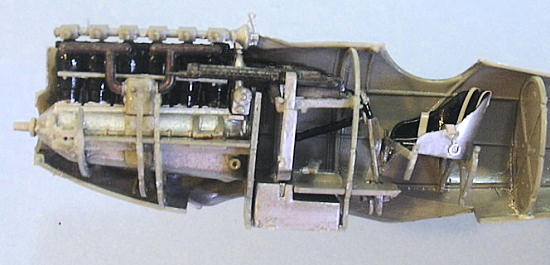 Construction starts with the engine.
Once this was assembled and painted, I began construction of the
fuselage. Fortunately, the interior is overall light grey, which I painted with Tamiya
“Sky Grey.” The internal bulkheads and engine mounts were attached with cyanoacrylate glue,
after which I attached the engine in position and put in the controls and seat.
I used the Eduard 1/32 German seatbelts, which improve the overall
look.
Construction starts with the engine.
Once this was assembled and painted, I began construction of the
fuselage. Fortunately, the interior is overall light grey, which I painted with Tamiya
“Sky Grey.” The internal bulkheads and engine mounts were attached with cyanoacrylate glue,
after which I attached the engine in position and put in the controls and seat.
I used the Eduard 1/32 German seatbelts, which improve the overall
look.
Because the plastic is thin and flexible, the
fuselage needs to be carefully assembled to limit the creation of an uneven
centerline seam.
If you do this carefully, you will only need a bit of cyanoacrylate glue
along the seam, covered after sanding down with Mr. Surfacer.
The lower wings and horizontal stabilizer attach easily, though I
needed both glue and Mr. Surfacer to smooth out the join of the wing to the
lower fuselage areas.
Painting:
The D.III was painted “Silbergrau,” a
color that is exactly as it says: “silvery-grey.”
I mixed Tamiya “Flat Aluminum” with Tamiya “Flat White” and painted
the model overall.
I lightened the color and went back over the wing ribs and areas of
the fuselage to give the effect of sun-fading on the paint - this was mostly to
try and make it less monochromatic.
I then masked off
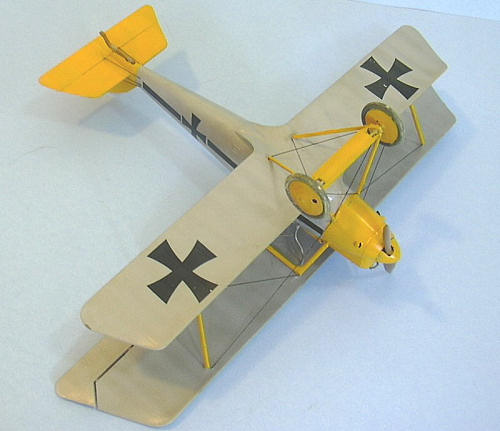 the nose and
tail, and painted those areas, the cabane struts, interplane struts, landing
gear, wheels and prop spinner
with Xtracrylix German “Gelb 04".
I painted the prop with my “Yew” color and streaked it with Tamiya
“Hull Red.”
the nose and
tail, and painted those areas, the cabane struts, interplane struts, landing
gear, wheels and prop spinner
with Xtracrylix German “Gelb 04".
I painted the prop with my “Yew” color and streaked it with Tamiya
“Hull Red.”
Decals:
Roden’s decals go down easily.
I used black stripe decals for stripes on the fuselage side.
I attached the landing gear after “muddying”
the wheels with Tamiya “mud” from their weathering set.
I then attached the cabane struts and interplane struts with
cyanoacrylate glue, and then attached the upper wing.
Getting the piping from the radiator to the engine was “fiddly,”
but this was the only hard part and it wasn’t that hard. The model was
rigged with .010 wire.
The Pfalz D.III may not have been one of the
outstanding performers of the First World War, but it is a good-looking
airplane, and one that served an important role in the final year of the Great
War. The
model is not difficult to do out of the box, and provides enough material for
someone to produce a beautifully-detailed “show stopper” with not that much
extra effort.
It looks great sitting next to the Albatros D.III and the two Fokker
triplanes. Highly recommended.
Thanks to Roden for the review kit.
Copyright ModelingMadness.com. All
rights reserved. No reproduction in part or in whole without express
permission.
If you would like your product reviewed fairly and quickly, please
contact
the editor or see other details in the
Note to
Contributors.
Back to the Main Page
Back to the Review Index Page2016




 seventh
victory was scored on April 13, 1917, when he shot down the F.E.2b flown by
7-victory ace Captain Lancelot Lytton Richardson who was killed and his observer
captured in this fight. Klein was wounded in action on May 9, 1917. Returning to
Jasta 4 in late June, he was wounded again on the morning of July 13,
1917, by which time he had scored 16 victories.
seventh
victory was scored on April 13, 1917, when he shot down the F.E.2b flown by
7-victory ace Captain Lancelot Lytton Richardson who was killed and his observer
captured in this fight. Klein was wounded in action on May 9, 1917. Returning to
Jasta 4 in late June, he was wounded again on the morning of July 13,
1917, by which time he had scored 16 victories.

 the nose and
tail, and painted those areas, the cabane struts, interplane struts, landing
gear, wheels and prop spinner
with Xtracrylix German “Gelb 04".
I painted the prop with my “Yew” color and streaked it with Tamiya
“Hull Red.”
the nose and
tail, and painted those areas, the cabane struts, interplane struts, landing
gear, wheels and prop spinner
with Xtracrylix German “Gelb 04".
I painted the prop with my “Yew” color and streaked it with Tamiya
“Hull Red.”